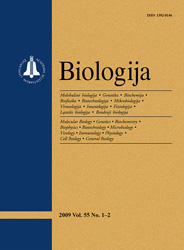Biologija / Biology
 ISSN 1392-0146 ISSN 2029-0578 (online) |
2006 m. Nr. 3 The use of ISSR method for the assessment of bee
genetic diversity
Genomic DNA assays of bee races Apis mellifera caucasica and Apis mellifera carnica and three lines of the latter were performed with eleven simple sequence repeat primers. Using these primers in PCR there were amplified 60 DNA fragments of which 66.7% were found to be polymorphic. The number of fragments produced in the DNA profiles of different bee races and lines varied from 2 to 10, with their sizes varying within 350–3000 bp. The genetic diversity of the individuals of A. m. caucasica and A. m. carnica races was revealed by using AC(GACA)4, (GACA)4GT, (ATG)5GA, (TCC)5GT, (AC)8YT and (CT)8A primers in PCR. Race and line-specific DNA profiles were obtained. Fragments specific to A. m. caucasica race were produced using (TCC)5GT, (AC)8YT and (AC)8T primers in PCR, and those specific to A. m. carnica lines were amplified by (AC)8YT primer. Having used eleven simple sequence repeat primers for DNA fingerprinting of bees, on average in 6.8% of the cases there were generated 5–7 types of DNA profiles, in 70.4% of cases 2–4 types of profiles, in the rest of 22.8% of cases any no polymorphism was revealed between the bee races and within the lines tested.
Keywords: honeybee, DNA, polymorphism, ISSR fingerprinting, primers |
Issues:
2011 - Vol.57 No. 1, No. 2, No. 3 2010 - Vol.56 No. 1-4 2009 - Vol.55 No. 1-2, No. 3-4 2008 - Vol.54 No. 1, No. 2, No. 3, No. 4 2007 - Vol.53 No. 1, No. 2, No. 3, No. 4 2006 No. 1, No. 2, No. 3, No. 4 2005 No. 1, No. 2, No. 3, No. 4 2004 No. 1, No. 2, No. 3, No. 4 2003 No. 1, No. 2, No. 3, No. 4 2002 No. 1, No. 2, No. 3, No. 4 2001 No. 1, No. 2, No. 3, No. 4 |